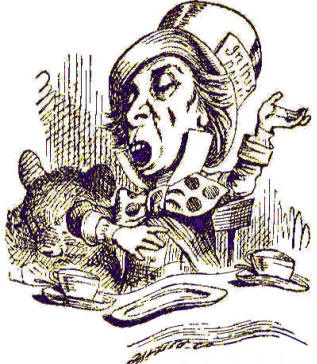'Mad as a Hatter'
The felt hat industry has been traced to the mid 17th century in France, and it was probably introduced into England some time around 1830. A story passed down in the hat industry gives this account of how mercury came to be used in the process: In Turkey camel hair was used for felt material, and it was discovered that the felting process was speeded up if the fibers were moistened with camel urine. It is said that in France workmen used their own urine, but one particular workman seemed consistently to produce a superior felt. This person was being treated with a mercury compound for syphilis, and an association was made between mercury treatment of the fibers and an improved felt. Eventually the use of solutions of mercuric nitratewas widespread in the felt industry, and mercury poisoning became endemic. (reference) Dementia and erethism were indeed a common ailment among 19th Century hatmakers.
The crazy Mad Hatter of Lewis Carroll's Alice in Wonderland is becoming widely associated with the effects of Mercury on behavior as well as physiology. Mercury was used to process the felt hats used in England around Lewis' time. Erratic, flamboyant behavior was one of the most evident alterations caused by mercury. (Others included excessive drooling, mood swings, various debilities.) (reference) But Lewis Carroll did not invent the phrase, although he did create the character. The phrases 'mad as a hatter' and "mad as a March hare" were common at the time Lewis Carroll wrote (1865 was the first publication date of Alice). The phrase had been in common use in 1837, almost 30 years earlier. |
|
The earliest mention of a 'mad hatter' appears to refer to one Robert Crab, a 17th Century eccentric living at Chesham, England. He gave all his goods to the poor and lived on dock leaves and grass. Carroll, however, seems to have based his mad hatter not on Robert Crab, but on a certain Theophilus Carter, not a hatter but a furniture dealer, who was known locally as the Mad Hatter, partly because he always wore a top hat, and partly because he was quite an eccentric and produced some wacky inventions. Makers of felt hats would indeed often drool, tremble, talk to themselves and have bouts of severe paranoia, for reasons that only became clear later. Both in Europe and North America they were the eccentrics and madmen of the clothing trades, which gave rise to the phrase as used today. (reference)
|
|
Lewis Carroll frequently used common expressions, songs, nursery rhymes, etc., as the basis for characters in his stories. The origin of the phrase, it's believed, is that hatters really did go mad. The chemicals used in hat-making included mercurous nitrate, used in curing felt. Prolonged exposure to the mercury vapors caused mercury poisoning. Victims developed severe and uncontrollable muscular tremors and twitching limbs, called 'hatter's shakes'; other symptoms included distorted vision and confused speech. Advanced cases developed hallucinations and other psychotic symptoms. Danbury, Connecticut, an important center of America’s hat-making industry until men's hats went out of fashion in the 1960's, developed its own reputation for madness. Regionally, the "Danbury shakes" were a commonly recognized series of ailments. |
On December 1, 1941 the United States Public Health Service banned the use of mercury in the felt industry in this country. Although it has been suggested that the expression 'mad as a hatter' and the character portrayed in Lewis Carroll's Alice in Wonderland may have other origins other than mercurialism among hatters, few can resist making this apocryphal analogy.
See also: Amalgamation, Appliances, Chlor-Alkali, Dentistry, Explosives, Iraq poisoning, 'Mad as a Hatter', Mercury, Methylmercury, Minamata, Minamata timeline, Medical uses, Pigmentand organic fungicide production, Toxicology
Danbury Shakes
Danbury Connecticut has always been known as "The Hat City". It was the hat making capital of the world in the 19th century. At the peak of the industry, five million hats a year were produced in 56 different factories in Danbury. A process called "carroting" was used in the production. Carroting involved washing animal furs with an orange-colored solution containing a mercury compound, mercury nitrate. The colorful solution facilitated the separation of the fur from the pelt and made it mat together smoothly. Workers would often be exposed to mercury vapors in the steamy air. (reference)
Many hatters with long-term exposure, particularly those involved in carroting, got mercury poisoning. Mercury poisoning attacks the nervous system, causing drooling, hair loss, uncontrollable muscle twitching, a lurching gait, and difficulties in talking and thinking clearly. Stumbling about in a confused state with slurred speech and trembling hands, affected hatters were sometimes mistaken for drunks. The ailment became known as "The Danbury Shakes". In very severe cases, they experienced hallucinations.
Erethism
Synonyms and related keywords: mad hatter's syndrome, metal fume fever, Minamata disease, methylmercury, methyl mercury, mercury poisoning, mercury toxicity, mercury-induced cognitive impairments, mercury intoxication, mercury exposure, prenatal mercury exposure.
Acute mercury exposure has given rise to psychotic reactions characterized by delirium, hallucinations, and suicidal tendency. Occupational exposure has resulted in erethism, with irritability, excitability, excessive shyness, and insomniaas the principal features of a broad-ranging functional disturbance. With continuing exposure, a fine tremor develops, initially involving the hands and later spreading to the eyelids, lips, and tongue, causing violent muscular spasms in the most severe cases. The tremor is reflected in the handwriting which has a characteristic appearance. In milder cases, erethism and tremor regress slowly over a period of years following removal from exposure. Decreased nerve conduction velocity in mercury-exposed workers has been demonstrated. Long-term, low-level exposure has been found to be associated with less pronounced symptoms of erethism, characterized by fatigue, irritability, loss of memory, vivid dreams, and depression WHO, 1976).


Connect with us
Contact us today